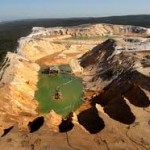Stradbroke Island has been in the news recently, following revelations that Belgian mining company, Sibelco, spent $91,000 at the last Queensland election in a successful attempt to unseat a politician opposed to extending its sand mining operations on the island. The former government’s policy was to end sand mining on North Stradbroke Island in 2019, while the incoming Newman government is proposing to extend mining to 2035, with the support of Sibelco.
In 2011 Economists at Large reviewed earlier assessment of Stradbroke sand mining for local group, Friends of Stradbroke Island.
A reader of our site recently asked us to take a look at the report, North Stradbroke Island – economic impact of mineral sands mining. While the report is published by the Queensland Department of State Development, Infrastructure and Planning, the economic assessment has been carried out by a private firm, Synergies Consulting, who were commissioned by Sibelco (see page 10 of the report, confusingly p28 of the pdf file).
Both the 2013 and the 2010 reports are based on a type of economic modelling called “input-output modelling”. While this methodology is widely used in Australia, its use in this case is surprising given the Queensland DIP’s involvement in publishing the research. The DIP’s policy is that projects should not be evaluated with input-output models, but through cost benefit analysis:
The primary method of economic evaluation of public sector policies and projects is cost- benefit analysis. Input-output methodology (or the use of multipliers) is not a preferred methodology for economic evaluations. (Qld DIP, 2011)p18
The reason why DIP and most Australian government departments prefer not to use input-output models is that they tend to exaggerate benefits and ignore costs completely. As Synergies point out:
The economic and environmental costs are not readily available and therefore the analysis assumed that the economic costs are already funded. (p10)
By ignoring the costs of sand mining, Synergies’ results overstate the economic case for the project. Furthermore, benefits are overstated as input-output models:
- Lack resource constraints – ie they assume resources are not taken away from other industries, or in this case, it assumes people currently working in sand mines will not work in any other industry or project. In reality, people with mining and engineering skills find work easily in other projects or industries.
- Assume fixed prices – ie they assume that wage levels and input costs would stay the same with or without the projects, whereas some reduction in these costs would result in the expansion of other industries.
- Are not appropriate for small areas – generally inputs to the models are based on state-wide estimates that do not reflect local conditions. The 2010 report claims to have developed a North Stradbroke Island-specific table, but no details are available.
Because of these limitations, the use of input output modelling for project assessment has been labelled “biased”, “abused” and “deficient” by the ABS ( 2011), the Productivity Commission and the NSW Land and Environment Court (Gretton, 2013; Preston, 2013). We believe the published results are a heavy overstatement. If cost benefit analysis had been conducted, the analysts would have had to address difficult issues:
- The company is foreign owned, so the vast bulk of financial benefits go offshore.
- Commodity price forecasts on which benefits are calculated are not mentioned in this report. Project proponents often use optimistic price estimates to make their projects seem more profitable, particularly if they do not need to disclose what prices they have used. In the current assessment, there is no way of assessing if estimates of profits and revenues are likely to be met as no price forecasts are provided.
- Royalty and tax rates are not mentioned. Analysts often use theoretical royalty and tax rates, but in reality many exemptions and write-offs lower government benefits from projects. No royalty and tax discussion is provided in this report.
- Environmental costs are not considered. No estimate of how much rehabilitation might cost and to what extent it will be able to mitigate the damage to the Stradbroke environment. This can be a major cost for proponents and of course for communities if rehabilitation is inadequate.
If thorough cost benefit analysis was conducted on the sand mining operations on North Stradbroke Island, it is likely that the results would suggest the economic welfare of the Island would be barely affected. While the extension of mining leases beyond their scheduled end would provide a windfall for Sibelco and their direct employees, these profits go overseas and most employees would soon find jobs in other mining projects and industries. Environmental costs and potential impacts on the tourism industry are, however, borne by the wider community and may be considerable. We hope economic analysis in line with DIP guidelines will be carried out before any decision is made.
References:
ABS. (2011). Australian National Accounts: Input-Output Tables – Electronic Publication, Final release 2006-07 tables. Australian Bureau of Statistics. Retrieved from http://www.abs.gov.au/AUSSTATS/[email protected]/Previousproducts/5209.0.55.001Main Features4Final release 2006-07 tables?opendocument&tabname=Summary&prodno=5209.0.55.001&issue=Final release 2006-07 tables&num=&view=
Gretton, P. (2013). On input-output tables: uses and abuses. Staff Research Note, Productivity Commission, Canberra. Retrieved from http://www.pc.gov.au/__data/assets/pdf_file/0008/128294/input-output-tables.pdf
Preston, B. (2013). Judgement on Bulga Milbrodale Progress Association Inc v Minister for Planning and Infrastructure and Warkworth Mining Limited. Judgement in the Land and Environment Court, New South Wales. Retrieved from http://www.edo.org.au/edonsw/site/pdf/casesum/Warkworth_judgment.pdf
Qld DIP. (2011). Project Assurance Framework: Cost Benefit Analysis. Analysis. Queensland Department of Infrastructure and Planning. Retrieved from http://www.treasury.qld.gov.au/office/knowledge/docs/project-assurance-framework-guidelines/paf-cost-benefit-analysis.pdf



Thank you Roderick,
Speaking as a non-economist who lives on the island but has spent some time considering “what is the real island economy” vs “what the mining company claims is the island economy”, your report strikes me as succinct yet particularly insightful and accurate.
One cost you may wish to also include is the active brake on the development of new businesses that are applied by the restrictions of long-term mining-leases (trespass, destruction of natural assets etc).
Thanks, Glen. If we do further work on this, we’ll certainly be interested in that angle.